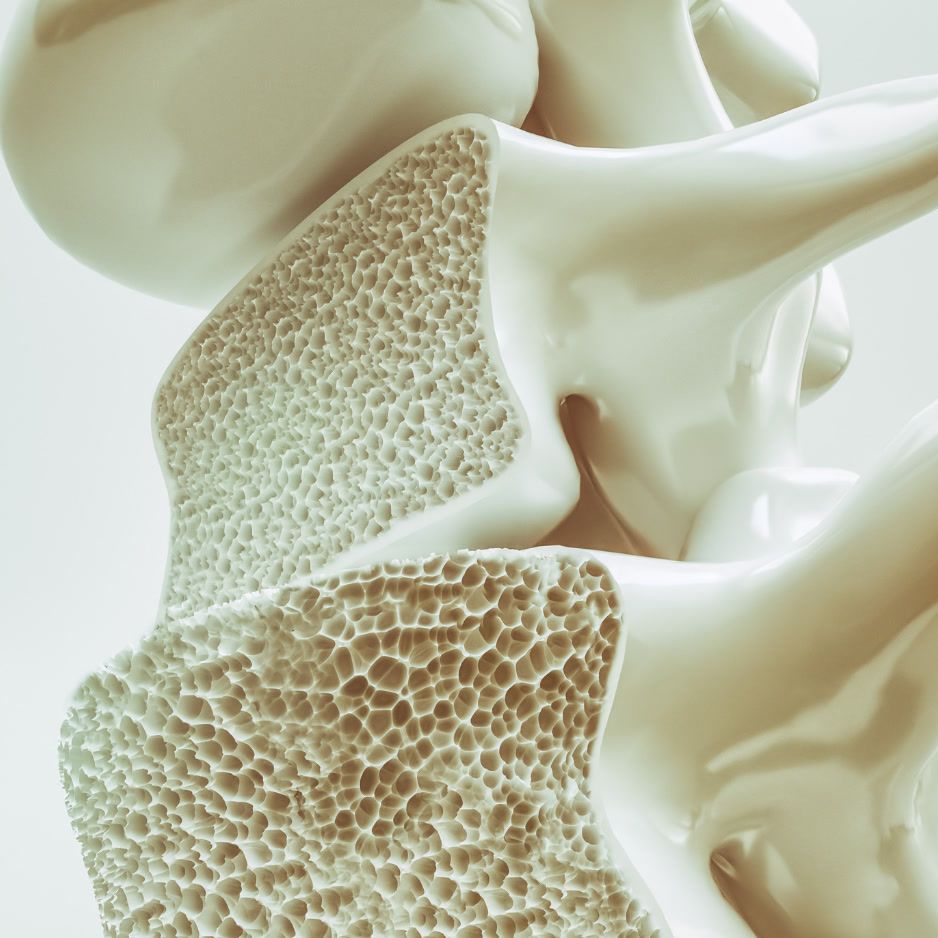8-Week Push-Up Challenge for Beginners

8-Week 100 Push-Up Challenge: A Beginner-Friendly Roadmap
Cranking out 100 textbook-quality push-ups in one go is a serious fitness milestone. It demands muscular endurance, core stability, and mental grit—no fancy equipment required.
Why bother? Because push-up capacity tracks closely with heart health. In a 10-year study of 1,104 firefighters, men who could complete more than 40 consecutive push-ups had a 96 % lower risk of heart-related events than those who topped out below ten (JAMA Network Open, 2019). While the research highlighted the 40-rep mark, building toward 100 reps multiplies the endurance challenge and offers an easily measured way to push beyond the “healthy” baseline.
Program Overview
Below is an 8-week roadmap (plus an optional 1-week Foundation phase) designed for beginners who currently perform fewer than 5 strict reps and intermediates alike.
• Frequency: 3 non-consecutive sessions per week
• Session length: ~15 minutes
• Timeline: 8 weeks (9 if you add the Foundation week)
• Tools: Just your body weight—and optionally a timer
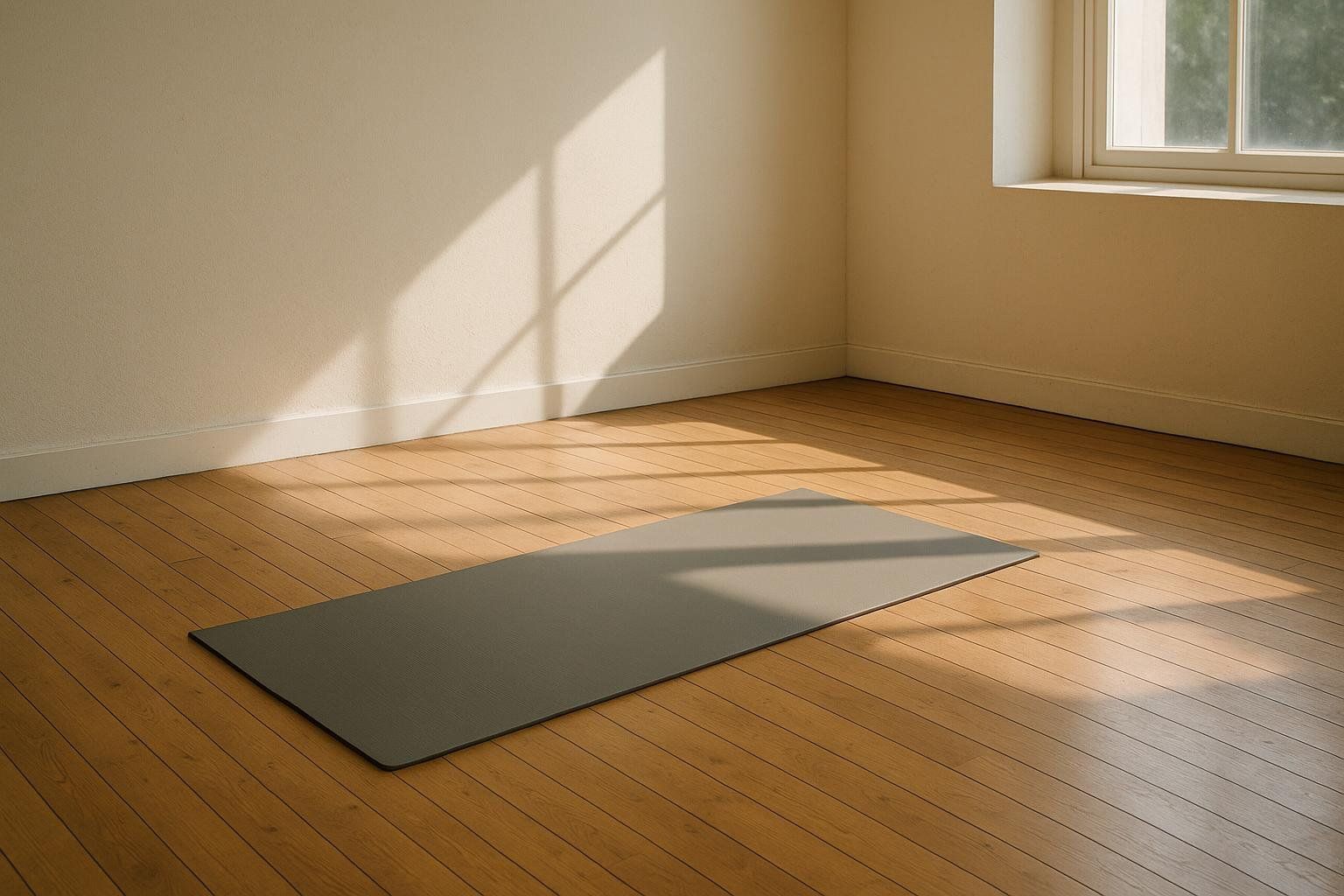
Pair those workouts with smart recovery, supportive nutrition, and periodic BodySpec DEXA scans to track changes in your lean-mass metrics.
Table of Contents
- Why Aim for 100 Push-Ups?
- Step 0 – Find Your Starting Point
- Push-Up Form 101
- The 8-Week Progression Plan
- Accessory Work & Mobility
- Recovery, Nutrition, and Sleep Essentials
- Apps & Tools to Stay Consistent
- Tracking Progress with BodySpec
- Frequently Asked Questions
1. Why Aim for 100 Push-Ups?
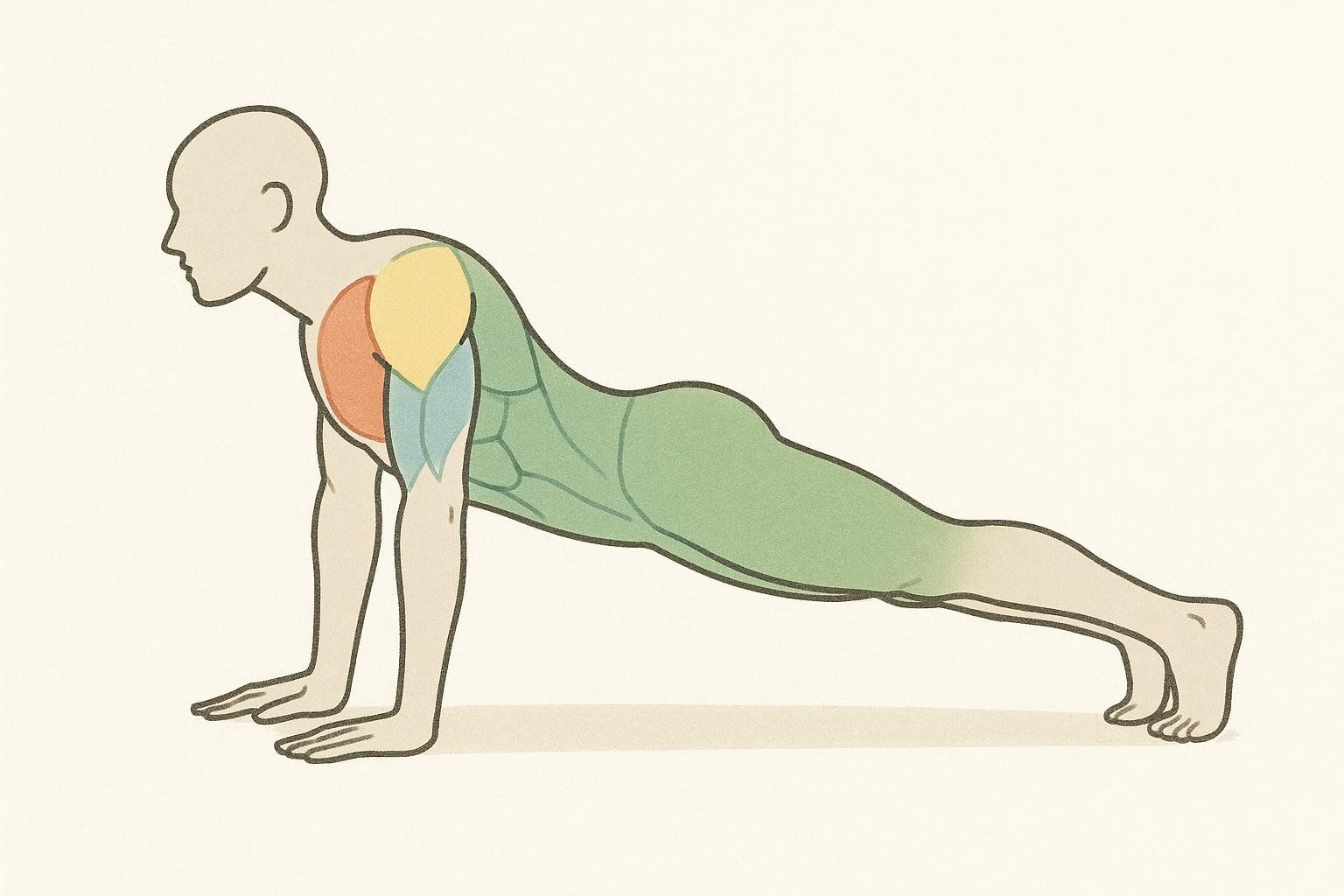
• Full-body strength. Standard push-ups recruit chest, shoulders, triceps, serratus anterior, and core stabilizers in one compound movement (Medical News Today).
• Joint integrity. Being a closed-chain exercise, push-ups teach your shoulder blades to glide properly, reducing risk in overhead sports.
• Cardio check-up. High push-up capacity correlates with lower cardiovascular disease risk (JAMA Network Open, 2019).
• No equipment. All you need is a clear floor and gravity.
• Easy progress tracking. Rep PRs require zero tech—just count.
Coach’s tip: Strength levels often improve week-to-week, while body-composition shifts take longer. Retest your push-up max every two weeks, but revisit DEXA data every 8–12 weeks.
2. Step 0 – Find Your Starting Point
- Warm up with arm circles, cat-cows, and 10 knee push-ups.
- Rest one minute, then perform as many strict push-ups as possible. Chest should lightly touch the floor; elbows lock out at the top.
- Record that number.
| Baseline Reps | Where to Begin |
|---|---|
| 0–4 reps | Complete the Foundation Week below, then start Week 1 |
| 5–14 reps | Start at Week 1 |
| 15–30 reps | Start at Week 3 |
| 31–50 reps | Start at Week 5 |
Foundation Week (for <5 strict reps)
Perform three sessions this week:
| Exercise | Sets × Reps |
|---|---|
| Knee push-ups | 5 × 6 |
| Incline push-ups (hands on a bench) | 3 × 5 |
| Scapular push-ups | 2 × 15 |
Rest 60–90 seconds between sets. When you can do 5–6 strict toe push-ups consecutively, move to Week 1.

3. Push-Up Form 101
- Set-up. Hands under—but just outside—shoulders, fingers spread. Feet together.
- Brace. Squeeze glutes and quads; think “plank with moving arms.”
- Descend. Elbows at ~45°; lower until chest lightly touches the floor.
- Drive. Exhale; press through palms to full lockout without sagging hips.
Common Faults & Fixes
| Fault | Why It Happens | Quick Fix |
|---|---|---|
| Elbows flare | Weak scapular control | “Screw” palms into floor to engage lats |
| Hips sag | Core/glute fatigue | Squeeze glutes; draw ribs down |
| Partial range | Fear of failure | Elevate hands on a box, maintain full ROM |
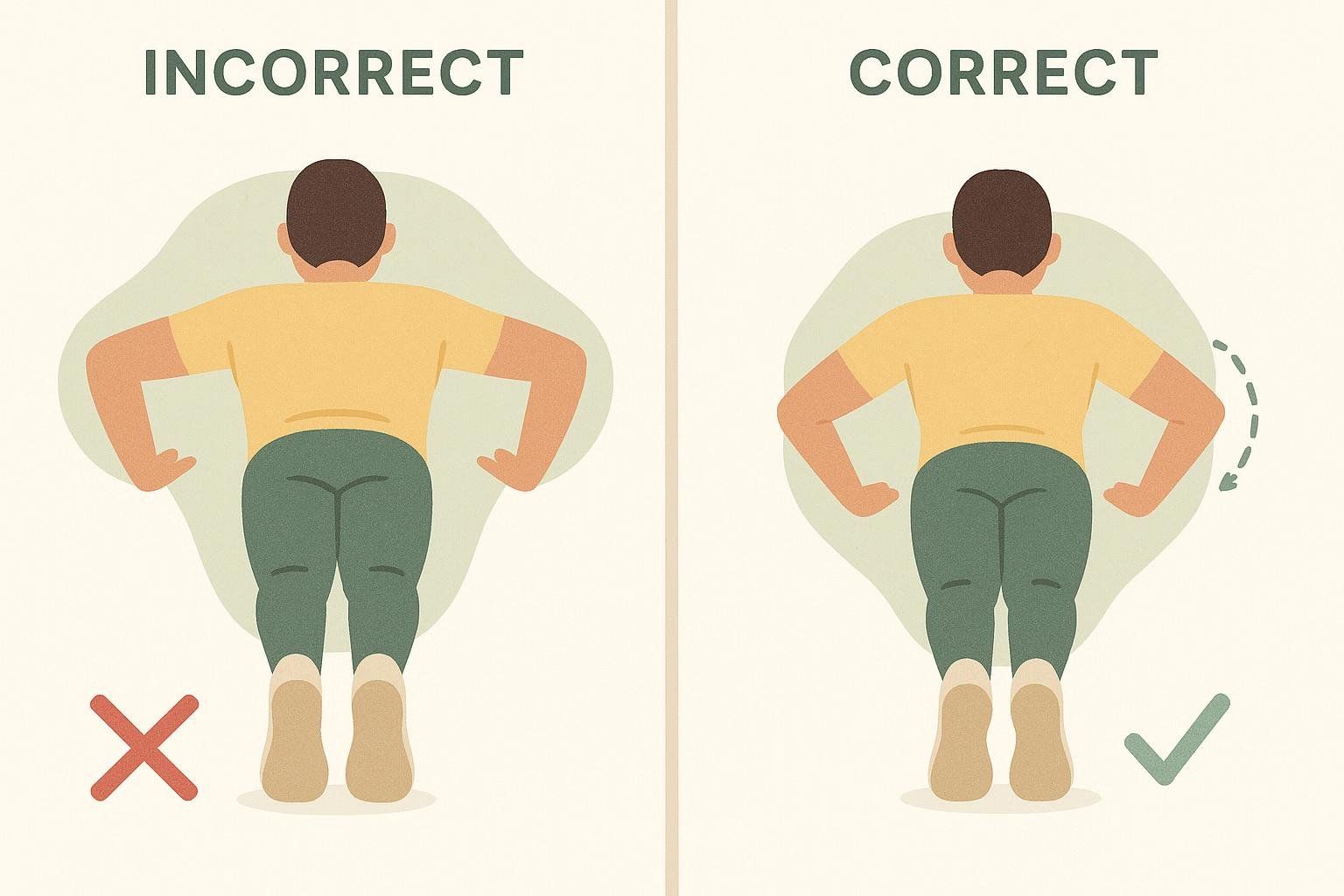
Beginner bonus: Knee push-ups build chest and arm strength nearly as effectively as toe push-ups (Les Mills Lab).
4. The 8-Week Progression Plan
Train three non-consecutive days (e.g., Mon/Wed/Fri). Each session uses ladder sets: perform Set 1, rest 60 sec, Set 2, and so on. If you easily finish every rep, jump to the next week early.
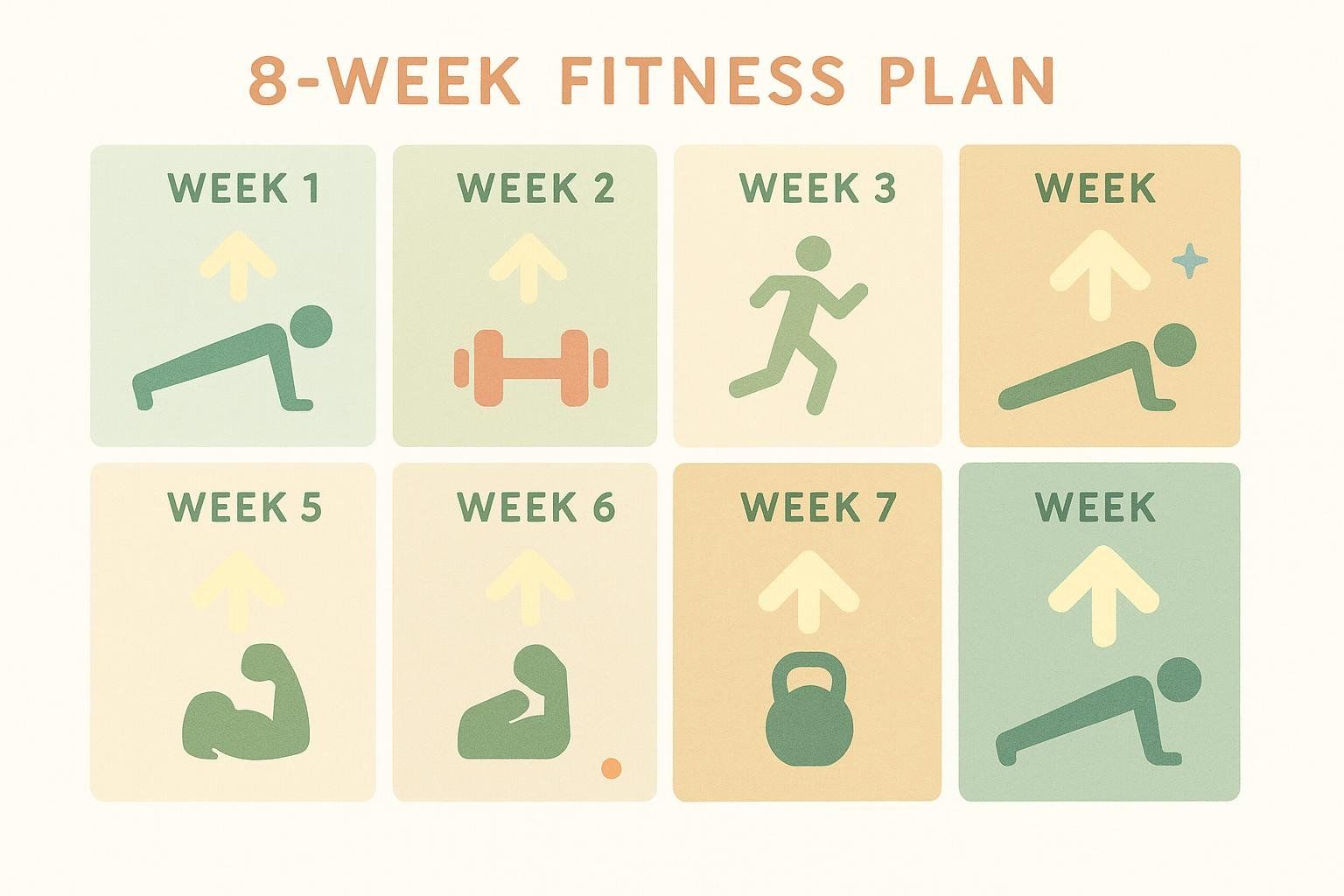
| Week | Set 1 | Set 2 | Set 3 | Set 4 | Set 5 | Total Reps |
|---|---|---|---|---|---|---|
| 1 | 5 | 5 | 4 | 4 | 3 | 21 |
| 2 | 7 | 6 | 5 | 4 | 4 | 26 |
| 3 | 9 | 8 | 7 | 6 | 6 | 36 |
| 4 | 12 | 10 | 8 | 6 | 6 | 42 |
| 5 | 15 | 12 | 10 | 8 | 8 | 53 |
| 6 | 18 | 15 | 12 | 10 | 10 | 65 |
| 7 | 22 | 18 | 15 | 12 | 12 | 79 |
| 8 | Max test | — | — | — | — | Aim: 100 |
Why the bigger workload in Week 7? It’s a common “peaking” technique—slightly overloading before a test helps prime strength endurance so you’re ready for the all-out effort in Week 8.
Progress Pointers
• If you miss a rep early, repeat the same week until successful.
• Feeling strong? Add a +2-rep bonus to Set 1.
• Still shy of 100 after Week 8? Repeat Week 7 or add a sixth mini-set of 10 reps.
5. Accessory Work & Mobility
| Move | Sets × Reps | Purpose |
|---|---|---|
| Scapular push-ups | 2 × 15 | Shoulder-blade control |
| Plank shoulder taps | 3 × 30 sec | Anti-rotation core |
| Resistance-band pull-aparts | 3 × 20 | Improve shoulder health & posture |
| Doorway pec stretch | 3 × 30 sec | Counter tight chest |

Looking for more ways to strengthen stabilizers and stay limber? Explore our guides on injury-prevention exercises and mobility and flexibility for injury prevention.
6. Recovery, Nutrition, and Sleep Essentials
Muscles grow between workouts, not during them. Prioritize:

• Rest days and active recovery. Low-intensity walks or mobility flows enhance blood flow without joint stress. Learn more about the importance of rest days and active recovery.
• Protein intake. Aim for ~0.7 g protein per pound of body weight, spaced over four meals. See our Nutrient Timing Guide for details.
• Importance of sleep for muscle recovery—seven to nine hours fuels hormone balance and motor learning.
7. Apps & Tools to Stay Consistent
- Hundred Pushups – classic 6-week ladder with audible cues (updated Jan 2025).
- Be Stronger 100 Pushups – gamified medals and built-in rest timers.
- Set a repeating phone alarm titled “Push-Up Power ⚡.” Simple yet effective.

8. Tracking Progress with BodySpec
A BodySpec DEXA scan offers objective proof of muscle gain. It quantifies lean mass in each limb, so you’ll know exactly how much upper-body muscle you’ve added by Week 8.
- Schedule a baseline scan before Day 1.
- Complete the challenge.
- Re-scan and compare side-by-side.
DEXA also provides:
• Visceral-fat score – gauges dangerous fat stored around organs.
• Total body-fat percentage & regional distribution – see where you’re losing fat first.
• Bone density (T-score & Z-score) – checks that push-ups support skeletal health.
• Resting metabolic rate (RMR) estimate – fine-tunes calorie targets.
Seeing these metrics next to your new push-up PR gives you a 360° view of health and performance.
9. Frequently Asked Questions
Q: I can only do push-ups from my knees. Does that still count?
Yes. Knee push-ups activate the same prime movers, just at lower loads. Progress by elevating hands, then moving to toes.
Q: Can I do push-ups every day?
Daily volume can work for advanced trainees, but beginners recover better with at least 48 hours between hard sessions. Remember: stimulus + recovery = growth.
Q: My wrists hurt—help!
Use neutral-grip push-up handles or try fists-on-floor versions. Persistent pain warrants a chat with a physical therapist.
Q: What if I fail the 100-rep test?
Repeat Week 7, or add a sixth set of 10 reps, and retest in one to two weeks.
Start your journey to 100 push-ups today—and celebrate your progress along the way!

